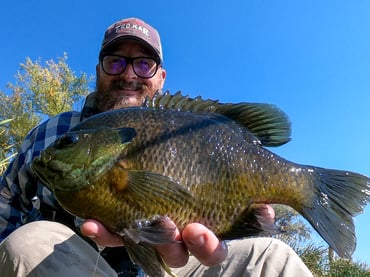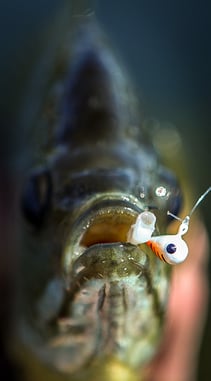
There are some writers that can get straight to the nitty gritty and skip over anything sentimental when it comes to fishing, I can’t. I sat down to write a simple how-to piece that illustrated where bluegill are located on docks and how to catch them… I’ll get to that, but not before confessing my everlasting love and admiration for what could very well be the finest gamefish species in freshwater, the almighty bluegill!
Catching bluegill is fun, damn fun, the kind of fun that never gets old. I don’t care if you’ve caught marlin longer than your truck, have won the Bassmaster Classic, or travel the world Jeremy Wade style, catching gills off a dock never gets old! Bluegill are made for anglers. They’re plentiful when selectively harvested, rarely too picky when it comes to what they’ll eat, taste great, and goodness gracious do they fight! Like little balls of muscle all hopped up on Mountain Dew and bad attitude, bluegill are the pound for pound champs of freshwater. There’s a reason millions upon millions of people have their angling passion ignited while catching bluegill, it’s fun!
Bluegill love docks. They provide all the necessities of life for a school of feisty bluegill to stay happy. Food, comfort, and safety are abundant for a bluegill thriving around docks, all the comforts provided by structure and cover.
Food: Bluegill have the never-ending, eat first ask later appetite similar to a teenage boy. As long as something vaguely appears edible they’ll engulf it first, and worry about the consequences later. Having an appetite like that, bluegill need to be around areas with a lot of food and docks can certainly provide the bulk and variety of food gills need to stay fat and sassy. Aquatic insects, flying insects, spiders, minnows, and even bread from people feeding ducks are all a part of the food smorgasbord that keep schools of bluegill happy around docks.
Safety: Bluegill hide under and around docks the same way your little brother hides behind curtains playing hide and seek with his sneakers clearly showing. As long as he feels like he’s hidden, well then, he’s hidden. It’s the same thing with bluegill around docks. Yes, the overhead cover provides a great deal of safety from birds, but the danger that lurks around docks for bluegill congregating there is very real. Bass, walleye, channel cats, and snakes are a few species drawn to docks to pillage through schools of bluegill, which you can use to your advantage as an angler as well when targeting those species.
 Comfort: During the blistering heat of summer gills seem to split up when they seek comfort. Some will seek deeper water near vegetation while others will stay under the shade created by the dock happy as can be.
Comfort: During the blistering heat of summer gills seem to split up when they seek comfort. Some will seek deeper water near vegetation while others will stay under the shade created by the dock happy as can be.
An angler can never go wrong dangling a little piece of crawler under a bobber on an Eagle Claw Baitholder Hook. This timeless presentation can and will catch everything that swims. As mentioned above, bluegill have ferocious attack firs,t think about it later attitudes. For that reason, I like to go with Baitholder hooks large enough to keep bluegill from swallowing everything, but not too big that it makes getting the hook in their mouth a chore. A size 8 seems to the perfect balance for most of the bluegill ponds I fish, but that could be a bit different in your neck of the woods.
Pro Tip: Even bluegill can shut down from time to time and the bite can get tough. When that happens there are two presentations I go to.
First, I’ll tie on a dry fly. I prefer a small Adams, but anything that remotely resembles a small flying insect will rarely go ignored. The key here is to keep the fly small, size 14-16; tiny bug-like jigs are perfect for fussy bluegill. Don’t worry too much about using a clear bubble or presenting the dry fly with a fly rod. All I do in this situation is cut off the baitholder and tie on the dry fly. Another great presentation when the bite gets tough is to break out the ice jigs and dangle one vertically off the side of the dock tipped with a wax worm or tiny piece of crawler.
Sign up for our E-Mail Newsletter by clicking "Find Fish" below. In between blogs, we're covering different approaches to finding fish with pros and offering tips that will help advanced and new anglers alike.

